[Pan Am 103 Series]
Adam Larson / Caustic Logic
January 9 2010
The BBC have a checkered history dealing with Lockerbie affair, from a dry but brilliant 1999 Dispatches episode to a 2008 Conspiracy Files one that tried for slick but felt just slimy with politicized distortions. They’ve now added a large bright patch with their approval a recent Newsnight episode, with Peter Marshall reporting on doubts about the key forensic clue in the case against Libya. It’s an encouraging development, a reminder that to some journalists, truth still matters more than politics after all, and the BBC will even allow those to speak up sometimes. (Or is there politics too behind a shift in perceptions at this time? Possible hidden subtexts will be considered in light of future political moves…)
Aired on Friday, 8 January, the program is currently viewable (to me anyway) here. It deals largely with circumstantial problems with the discovery and handling of the crucial timer fragment PT/35(b). Central to establishing a Libyan link to the bombing, it’s been especially bogged down with a slew of valid questions, recounted by Marshall and nothing new to me – no chemical tests to determine if it was in an explosion, unusually changed evidence label, incredulity over the slowness of identification, perhaps hints of backdating records to cover for an item planted later, etc.
James T. Thurman, the FBI political scientist credited with the visual match between PT/35(b) and a Libyan MST-13 timer, was interviewed again. He gave his usual story (more or less), saying “ahhtem” way too often. Marshhall tries to corner Thurman on failing to do real forensics and relying solely on a visual pattern-match. But this seems a little off-track on a reasonably important distinction; Thurman’s visual ID work, replicable by any trained parrot, was to identify the source of the fragment, not to replace forensic tests. The British scientists at RARDE were tasked with this (If I’m not mistaken), but it was not done, they said, as it was redundant – the fragment was clearly in the explosion, as that's what they were investigating, and the shirt collar it was lodged in was torn and burnt (and NOT labeled "made in Malta, to quibble on a small error made in the video).
 Otherwise the program is excellent, mostly for what’s really new about it and has people talking - new experimental evidence indicating PT/35(b) would have never been found if it were in the explosion. These were carried out by a Dr. John Wyatt, an explosives expert retired from the British Army, with decades of hands-on experience. Currently he heads a security consulting company called SDS, and is blast consultant for the United Nations, Europe and North Africa region. The details behind how he came to test the official scenario – twenty times over - is unclear at the moment, and so far there’s been no detailed report of his methodology and precise findings. But as it appears, another serious blow to Megrahi's conviction and Libya's vilification has been landed squarely.
Otherwise the program is excellent, mostly for what’s really new about it and has people talking - new experimental evidence indicating PT/35(b) would have never been found if it were in the explosion. These were carried out by a Dr. John Wyatt, an explosives expert retired from the British Army, with decades of hands-on experience. Currently he heads a security consulting company called SDS, and is blast consultant for the United Nations, Europe and North Africa region. The details behind how he came to test the official scenario – twenty times over - is unclear at the moment, and so far there’s been no detailed report of his methodology and precise findings. But as it appears, another serious blow to Megrahi's conviction and Libya's vilification has been landed squarely. From what Marshall explains in voice-over, Dr. Wyatt carried out his twenty tests over time, starting with the radio bomb detonated by itself. One sample he showed the cameras is at right, a suitcase filled with random clothes, and a radio (different model than alleged, a bit larger), rigged as a bomb and set in a homemade cardboard box. Another he showed contained yet another type of radio, bright red, and a suicase he says is the same model used for PA103 (Samsonite hardside). Both were soon after blown up with the pat of plastic explosives tucked inside. Of the consistent results, Wyatt told Newsnight:
From what Marshall explains in voice-over, Dr. Wyatt carried out his twenty tests over time, starting with the radio bomb detonated by itself. One sample he showed the cameras is at right, a suitcase filled with random clothes, and a radio (different model than alleged, a bit larger), rigged as a bomb and set in a homemade cardboard box. Another he showed contained yet another type of radio, bright red, and a suicase he says is the same model used for PA103 (Samsonite hardside). Both were soon after blown up with the pat of plastic explosives tucked inside. Of the consistent results, Wyatt told Newsnight:“I must admit, since the quantity of explosives we were using was only three or four hundred grams, I thought there were going to be some remnants of the radio left. But it – it – (chuckling) it just totally disintegrated. I mean really just went into tiny, tiny bits."
Wyatt elaborated a bit on method to The Times of Malta, specifying a separate timer was included and considered, as well as the general radio unit, and that the tests were done in varying conditions.
"We tried exploding the device on its own; in a radio similar to the one it was supposed to have been planted in; in a suitcase with and without clothes; surrounded by other suitcases and, eventually, in a container. In all tests, the timer and the circuit board were completely destroyed."
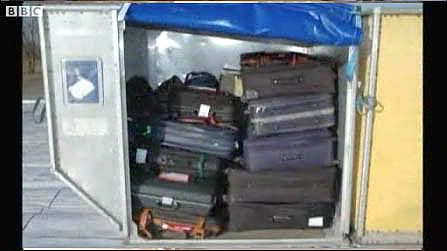 He later “built the tests up” to a finale – a dozen or so pieces of luggage piled in an airliner luggage container, arranged among other containers, and detonated in a field, videotaped from several viewpoints. This last was the only outdoors test; he told the Times he had done the other 19 indoors, “to make sure we could collect all the evidence.” Collecting the remains is what it was all about, of course, and so they used sparse concrete rooms (rather than a hundreds of square km countryside) and “we even painted the circuit board bright yellow to make it easier to identify any fragments among the debris. In no circumstance did we find any fragment," Dr Wyatt explained. Presumably he means no fragments of the scale of PT/35(b), since elsewhere he does mention “tiny tiny bits.” Perhaps the yellow was simply cooked off in all cases?
He later “built the tests up” to a finale – a dozen or so pieces of luggage piled in an airliner luggage container, arranged among other containers, and detonated in a field, videotaped from several viewpoints. This last was the only outdoors test; he told the Times he had done the other 19 indoors, “to make sure we could collect all the evidence.” Collecting the remains is what it was all about, of course, and so they used sparse concrete rooms (rather than a hundreds of square km countryside) and “we even painted the circuit board bright yellow to make it easier to identify any fragments among the debris. In no circumstance did we find any fragment," Dr Wyatt explained. Presumably he means no fragments of the scale of PT/35(b), since elsewhere he does mention “tiny tiny bits.” Perhaps the yellow was simply cooked off in all cases? 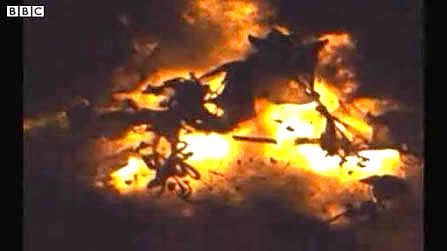 At right is a dramatic image from one of the tests, in a darkened room and greatly slowed down. The curly stuff is presumably the "hard-side" suitcase material, the little bars parts of its frame. The white-hot cluster at center is that 3-400 grams of explosive, semtex it should be, consuming the whole radio and vaporizing/weaponizing everything around it. Do consider that the bomb penetrated the plane's hull, after losing force bursting from the luggage container, after tearing through the suitcase lining, surrounding clothes, cardboard box, and the radio's plastic casing. The timer would be got to right away, before any energy was lost in an of those battles. Is Wyatt's testing just an elaborate (and expensive) way of proving the patently obvious?
At right is a dramatic image from one of the tests, in a darkened room and greatly slowed down. The curly stuff is presumably the "hard-side" suitcase material, the little bars parts of its frame. The white-hot cluster at center is that 3-400 grams of explosive, semtex it should be, consuming the whole radio and vaporizing/weaponizing everything around it. Do consider that the bomb penetrated the plane's hull, after losing force bursting from the luggage container, after tearing through the suitcase lining, surrounding clothes, cardboard box, and the radio's plastic casing. The timer would be got to right away, before any energy was lost in an of those battles. Is Wyatt's testing just an elaborate (and expensive) way of proving the patently obvious?Consider the "trial loading" below used at trial (best quality I could find, labels unreadable). This is the alleged bomb - a Toshiba RT-SF16 "Bombeat" radio with explosive, a detonator rod, battery (upper right label?) and MST-13 timer all fitting in a remarkably small case. It has the cassette assembly, about 4 inches wide, removed to allow the pat of semtex (312 grams of Semtex-H, most sources say - about 11 ounces). This makes the timer, it seems, no more than two inches from that origin of the blast - inches of mostly air, not lead. It's a chunk of this unit that survived and proves Libya's guilt? Do these people feel anything would be vaporized by an explosion like that? I feel stupid for ever even entertaining the notion.
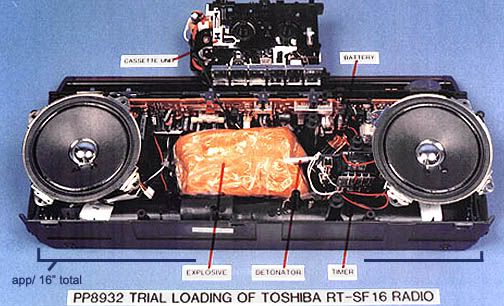
The official story line, that whole nations have moved by, is of course that a surviving bit of circuit board from within a supposedly similar explosion was found, in a non-controlled environment (southern Scotland). Furthermore, it was a strangely readable portion of a board solidly associated with Libya alone (more or less), and constituted proof of Libyan responsibility. Presented by Newsnight host Peter Marshall with this basic notion, Dr. Wyatt stopped precisely this far short of calling it all a grand farce:
"Obviously these things are not impossible, we only carried out 20 tests, we didn't carry out 100 or 1,000 tests, but in every of those 20 tests we found absolutely no sign at all. So I find it highly improbable that you would find anything like that, particularly at 10,000 feet when bits are dropping into long wet grass over hundreds of miles. […] I do find it quite extraordinary and I think highly improbable, and most unlikely that you would find a fragment like that – I mean, it is unbelievable.”
---


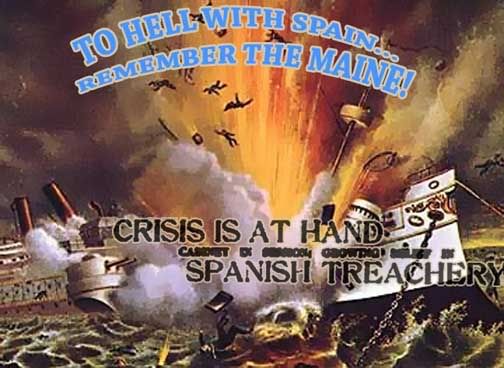
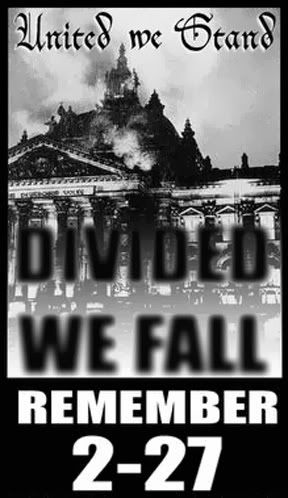


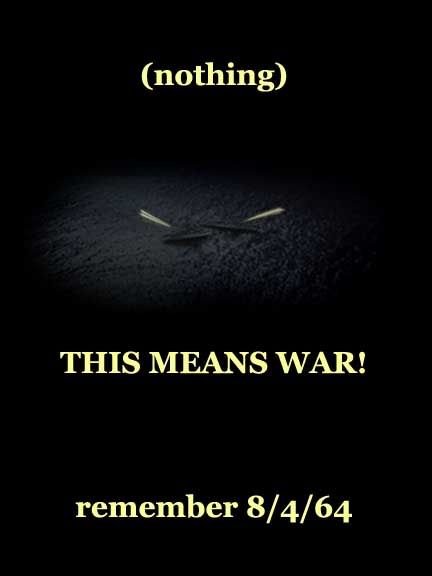


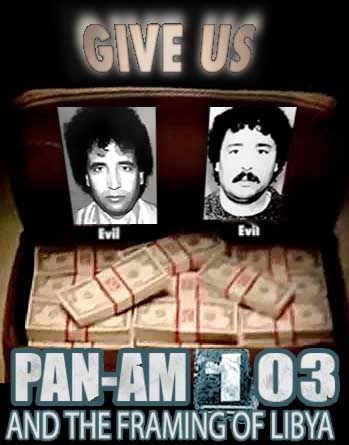



No comments:
Post a Comment